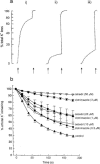Differences in the actions of some blockers of the calcium-activated potassium permeability in mammalian red cells
- PMID: 10051133
- PMCID: PMC1565796
- DOI: 10.1038/sj.bjp.0702292
Differences in the actions of some blockers of the calcium-activated potassium permeability in mammalian red cells
Abstract
1. The actions of some inhibitors of the Ca2+-activated K+ permeability in mammalian red cells have been compared. 2. Block of the permeability was assessed from the reduction in the net loss of K+ that followed the application of the Ca2+ ionophore A23187 (2 microM) to rabbit red cells suspended at a haematocrit of 1% in a low potassium solution ([K]0 0.12-0.17 mM) at 37 degrees C. Net movement of K+ was measured using a K+-sensitive electrode placed in the suspension. 3. The concentrations (microM +/- s.d.) of the compounds tested causing 50% inhibition of K+ loss were: quinine, 37 +/- 3; cetiedil, 26 +/- 1; the cetiedil congeners UCL 1269, UCL 1274 and UCL 1495, approximately 150, 8.2 +/- 0.1, 0.92 +/- 0.03 respectively; clotrimazole, 1.2 +/- 0.1; nitrendipine, 3.6 +/- 0.5 and charybdotoxin, 0.015 +/- 0.002. 4. The characteristics of the block suggested that compounds could be placed in two groups. For one set (quinine, cetiedil, and the UCL congeners), the concentration-inhibition curves were steeper (Hill coefficient, nH, > or = 2.7) than for the other (clotrimazole, nitrendipine, charybdotoxin) for which nH approximately 1. 5. Compounds in the first set alone became less active on raising the concentration of K+ in the external solution to 5.4 mM. 6. The rate of K+ loss induced by A23187 slowed in the presence of high concentrations of cetiedil and its analogues, suggesting a use-dependent component to the inhibitory action. This was not seen with clotrimazole. 7. The blocking action of the cetiedil analogue UCL 1274 could not be overcome by an increase in external Ca2+ and its potency was unaltered when K+ loss was induced by the application of Pb2+ (10 microM) rather than by A23187. 8. These results, taken with the findings of others, suggest that agents that block the red cell Ca2+-activated K+ permeability can be placed in two groups with different mechanisms of action. The differences can be explained by supposing that clotrimazole and charybdotoxin act at the outer face of the channel whereas cetiedil and its congeners may block within it, either at or near the K+ binding site that determines the flow of K+.
Figures







References
-
- ALVAREZ J., MONTERO M., GARCIA-SANCHO J. High-affinity inhibition of Ca2+-dependent K+ channels by cytochrome- P-450 inhibitors. J. Biol. Chem. 1992;267:11789–11793. - PubMed
-
- ARMANDO-HARDY M., ELLORY J.C., FERREIRA H.G., FLEMINGER S., LEW V.L. Inhibition of the calcium-induced increase in the potassium permeability of human red blood cells by quinine. J. Physiol. 1995;250:32P. - PubMed
-
- BENJAMIN L.J., BERKOWITZ L.R., ORRINGER E., MANKAD V.N., PRASAD A.S., LEWKOW L.M., CHILLAR R.K., PETERSON C.M. A collaborative, double-blind randomized study of cetiedil citrate in sickle cell crisis. Blood. 1986;67:1442–1447. - PubMed
-
- BENTON D.C.H., ATHMANI S., ROXBURGH C.J., SHINER M.A.R., HAYLETT D.G., GANELLIN C.R., JENKINSON D.H. Effects of cetiedil and its analogues on the Ca2+-activated K+ permeability of rabbit erythrocytes and on levcromakalim-stimulated 86Rb+ efflux from rat aorta. Br. J. Pharmacol. 1994;112:466P.
Publication types
MeSH terms
Substances
Grants and funding
LinkOut - more resources
Full Text Sources
Medical
Miscellaneous

